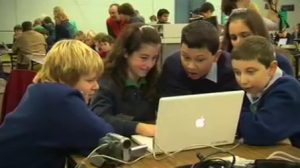During my five school visits, I have seen ICT being used sometimes; however, after reading Transforming learning with ICT by Finger, Russell and Jamieson-Proctor, I have realised that it could be used more frequently and more effectively.
The use of ICT that I have witnessed in my classroom has been the use of the interactive whiteboard and the use of the computer for interactive maths games. Based on what I have seen, the interactive whiteboard has been used no differently then the standard whiteboard, as it has only been used to write on and to show basic slides. The students really enjoy writing on the board; however, they would benefit more from interactive activities where they manipulate the contents on the board. Personally, I think the interactive board can be limiting, as I have only ever seen one student being able to complete the task on the board as the rest of the class watch without doing any active learning themselves. Therefore, I would use the interactive board in small group activities such as work stations in which students rotate between tasks. This maximises the use of the board as each student has a chance to be more actively involved with the board whilst other students are still actively working on other tasks.
I believe that ICT should be incorporated into the classroom as much as possible as it develops students ICT skills and relates their learning to the real world (Finger, Russell, Jamieson-Proctor, 2007).
I think that ICT should be used to further assist the student to achieve the learning outcome, not just for the sake of using it (Finger, Russell, Jamieson-Proctor, 2007). I think that teachers often just allow their students to work on the computer playing already developed games so that they can tick the box that they have incorporated ICT into their teaching. On the other hand, effective teachers use ICT as a mindtool for their students by using ICT to enhance the students ability to think deeper, solve problems and create their own knowledge and skills (Finger, Russell, Jamieson-Proctor, 2007). The use of ICT in the classroom allows students to actively control their own learning rather then passively absorbing information provided by the teacher (Finger, Russell, Jamieson-Proctor, 2007).
When teachers use ICT effectively in their classrooms they are ensuring that they follow teaching standard 4 as they are using ICT to foster interest and support learning.
Finger, G., Russell, G., Jamieson-Proctor, R & Russell, N. (2007). Transforming learning with ICT:Making IT happen. Frenchs Forest: Pearson Education Australia.






